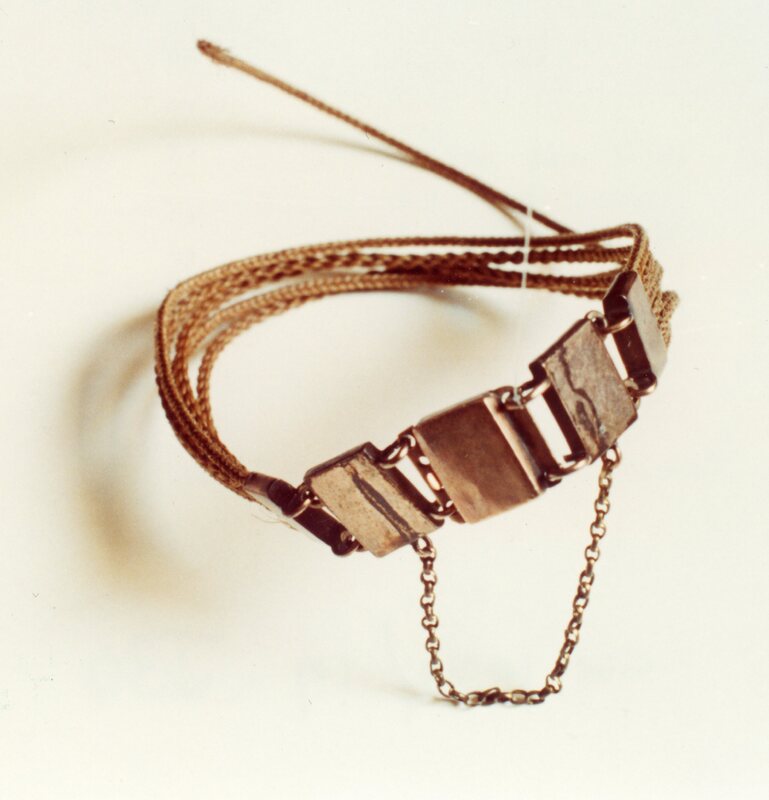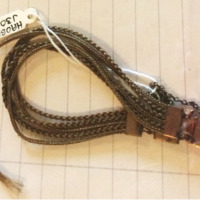-
Title
-
The Brontë Family's Broken Hair Bracelet
-
Description
-
This simple but sophisticated nineteenth-century hairwork bracelet is composed of six thin plaits of light brown hair, joined together at each end by metal clasps. The photographs above show the bracelet, housed at the Brontë Parsonage Museum in Haworth, in its current state. Uniformly muted in colour but slightly iridescent, the golden tinge of the hair complements the glinting metal in the flat links of the clasp. A partially obscured safety chain connects the two clasps at the ends of the bracelet, hidden underneath the body of the piece. The bracelet features two kinds of braid, alternating between the two styles to achieve an illusion of complexity and intricacy when viewed from afar. There is, however, one broken plait that has detached from the rest; having become partially unraveled, these hairs splay out loosely in all directions. The hair at the end of the broken plait still holds an imprint of its previous braided configuration, a subtle imprint that persists despite the passage of time.
-
HEATHER HIND ON WHAT THIS OBJECT TEACHES US:
For Dr. Heather Hind, hairwork makes manifest touch, labour, creativity, and the desire to preserve and beautify in anticipation of distance or death. Accordingly, this partially broken bracelet shows how hairwork can at once “endorse and deny connection”; it can also emphasize the threats of distance, death, and decay the bracelet may have been intended to ease.
When purchased by the Brontë Parsonage Museum, this bracelet was said to have belonged to Charlotte Brontë. However, Dr. Hind points out that its shade is closest in colour to Anne Brontë’s golden-brown locks. Thus, Dr. Hind reminds us that we must speculate about who made, who wore, and who broke this bracelet. Moreover, while there are records of the Brontës’ other handicraft activities, there is no clear evidence that they made the hair jewelry in their possession. Given the wider context of hairwork at the time, Dr. Hind suggests that one family member may have worked the hair before taking or posting it to a jeweler to be finished—especially because this bracelet is plaited and therefore likely worked without a hairwork table or frame.
Dr. Hind suggests that the experience of wearing the bracelet results in a more intimate appreciation of its repeated patterns: while the tubular shapes of other hair bracelets in the collection would stand away somewhat from the body when worn, this set of light, pliant plaits would brush against the wrist. The fine splinters of hair along the length of each plait are barely visible but can be felt by the wearer and were perhaps created by the bracelet rubbing up against a sleeve. Thus, Dr. Hind posits that the bracelet affects, in this roughened texture, a “reciprocal touch,” as if the owner had worn their touch into the bracelet with use and time. Indeed, the bracelet’s functional clasp and safety chain reinforce the idea that it was made to be worn, not only to be on display.
There remains, however, the one broken plait that stands away from the rest. The broken plait still holds its crimp, an imprint of its intended form, which Dr. Hind suggests demonstrates the vitality imparted into the hair and the force of the hand that worked it, as well as the susceptibility of this “fragile memento” to breakage. She notes that hairwork necessitates gripping hair between the fingers, smoothing it down, dividing it into strands, pulling it taut, and twisting, plaiting, weaving, or in some other way manipulating it with care, dexterity, and purpose. Hairwork thus figures and attempts to preserve touch in a way that unworked hair does not. While locks of hair may be cut and kept as mementos of family members, friends, or lovers, to Dr. Hind, hairwork “codifies the dynamics of these relationships.” The way that hair is kept carefully plaited and fixed in place by hairwork becomes a “metaphoric anchor” for a network of ideas, identities, and alliances.
Additionally, for Dr. Hind, hairwork is a product not only of the body from which it was taken but also of the body that works and then wears it. She reminds us that each time hair passes between hands to be cut and exchanged, to be worked at, and to be worn, it is impressed to some degree by its contact with the body. Yet when its hairs are damaged or pulled apart by excessive touch, as we see in this bracelet, this token of connection might actually “effect disconnection.” Overall, for Dr. Hind, the hairwork bracelet becomes a symbol of eternity that can easily be broken, made unstable and uncertain, suggesting the prospect of loss as much as continuation.



